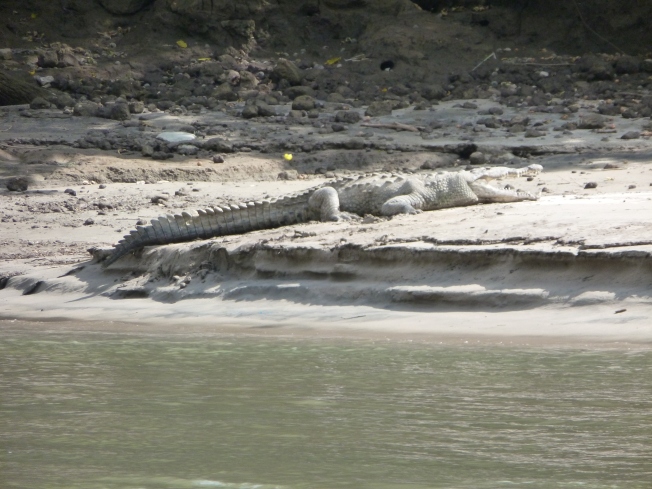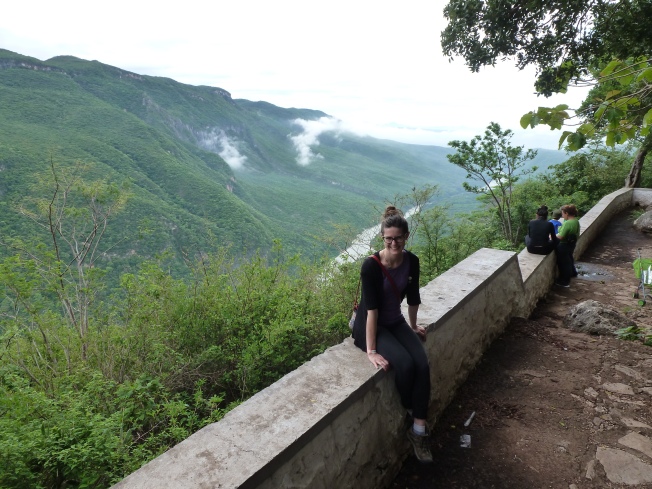My first morning in Tuxtla, Tio Milton was back bright and early to take Valeria and I to los miradores del Cañón del Sumidero, a winding road up the mountain with glorious views of the canyon below. This area is linked to the Chiapa people, who occupied the Central Valley area before the arrival of the Spanish. Their main settlement was in Chiapa de Corzo near the canyon, with a fortified area higher up for protection from invasions. The Chiapa fiercely resisted Spanish conquest for years, with their last refuge in the fortified area, now known as the archeological site of the Ruins of Berlin. When the Spanish took over the main city in 1528, the Chiapa still retained their stronghold until 1535. Legend has it that when this last fortification fell, the remaining Chiapa committed collective suicide by jumping into the canyon. Since then, the canyon has served as a boundary marker between the Zoque and Tzotzil peoples.
We then passed a relaxing afternoon wandering the streets of San Cristobal de las Casas (whose name in the Tzotzil and Tzeltal languages is Jovel, or “the place in the clouds”), visiting churches dating from 1528 and admiring Valeria’s haggling skills with the feria artists.
For lunch, Milton treated us at Los Jardines de San Cristobal, a sprawling restaurant renowned for el buffet that gave me a chance to sample all Tuxtla’s favourite comidas: la sopa de chipilín, el cochito adobado, pollo con mole, platanos fritos, dulces de calabaza. To drink: el tascalate, a mix of corn, cocoa, achiote, cinnamon, and sugar (that I am slightly addicted to).
——————————————————————————-
The following weekend, Valeria and I returned to el Cañón, but this time, from abajo (below)! In the 39°C weather, Valeria and I and the other SCOPE students attempted to stay cool (ha!) by guzzling Chiapa de Corzo’s renowned pozol, an indigenous chiapeneco drink made from ground roasted white corn that is then mixed by hand with water, cocoa, and pochotl:
We then rented a boat and spent the day exploring Chiapa de Corzo and el río Grijalva, keeping our hands safely inside the boat as we snapped photos of some of Grijalva’s more intimidating residents…
Sandra (SCOPE student from Colombia), yo, Valeria, y Diego (from Tuxtla)

Diego and Valeria can be frightening 😉 but they’re not whom I’m referring to…

Faces in this photograph are as amazed as they appear!

Endangered American river crocodiles

The Shrine of the Virgin Guadalupe in La Cueva de Colores (Cave of Colors), named for the filtration of magnesium, potassium and other minerals which colour the walls pink

The walls of the Canyon stretch up over 1000m

Cascada Árbol de Navidad (Christmas Tree Waterfall): the “branches” of the Árbol are made by deposits from the waterfall which are then covered in moss.


Chicoasén Dam, one of many hidroeléctricas that provide power to 70% of Mexico (take note of the snack boat ready for service!)


***EDIT*** A month later, when Josh joined me in Chiapas, we returned to the Cañón and found that the cocodrilos were feeling even more photogenic this visit… we saw over 10 crocodiles in 2 hours!!























the scenery is amazing. How wonderful!
LikeLike
Amazing photos – wow!
LikeLike
Seriously, I’ve never heard of a culture with food combinations as random as Mexicans. They are the true culinary hipsters. ¡Les amo, locos!
LikeLike
It’s so true. The ultimate example: La Chamoyada = chamoy (chiles, corn cob, salt, sugar, and vinegar) poured over ice, then topped with 5-cent candies and a tamarindo stick, then sprinkled with more salt & chiles. ?!?!?
LikeLike
Is it good??
LikeLike
Um… no, it is not. It’s actually a big joke here, bc my family knows that “Sara loves EVERYTHING in Mexico… except chamoy!!” 😛
LikeLike
To be fair, the tamarindo stick is delicious.
LikeLike
Cedar and Meadow will be so jealous that you got to hang out with Diego. Clearly he is Dora’s cousin, non?
That crocophant was crazy cool!!
LikeLike
ps — am emailIng you a comment that I won’t post on your blog. 🙂
LikeLike
Ooh, what’s the censored comment?? 😛
LikeLike
Haha. I emailed it to your blog’s email.
LikeLike
Ps thank you for paving the way for another chamoy-averse Canadian. I’ve gotten very into tortillas de maiz over the last couple days, though!
LikeLike
Pingback: Collision | saratreetravels